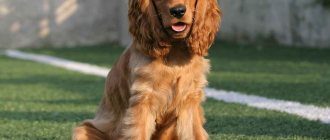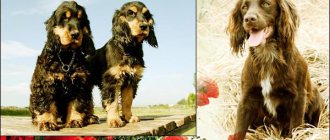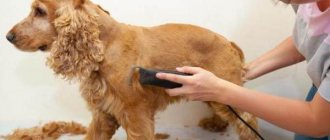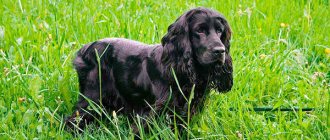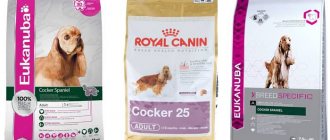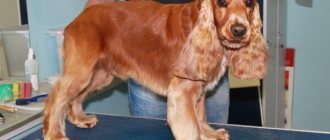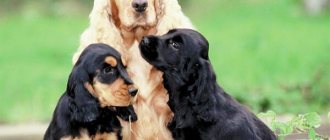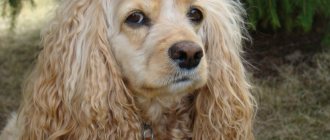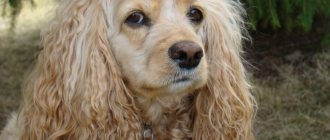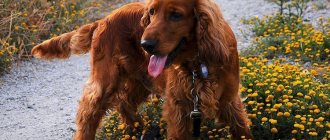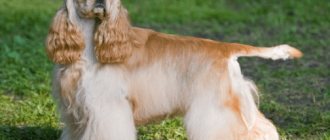February 2847895dog breeds spaniel
The English Cocker Spaniel is a wonderful breed of dog that is perfect as a pet and will bring a lot of joy to its owner. The English Cocker Spaniel breed is a hunting breed and was previously used only for bird hunting. Today the English Cocker Spaniel dog is a popular pet; it is very good-natured and active. In this article you will find a lot of interesting and useful information about the English Cocker Spaniel dog.
Video
* We invite you to watch a video about the English Cocker Spaniel . In fact, in front of you is a playlist in which you can select and watch any of 20 videos about a given dog breed by simply clicking on the button in the upper right corner of the window. In addition, the material contains quite a lot of photos. By looking at them you can find out what an English Cocker Spaniel looks like.
In this article:
|
Price range
Ideal representatives of the breed without any flaws and having all the necessary documents cost about 20-25 thousand rubles.
A puppy with a good pedigree, but with minor defects in the exterior, will cost approximately 12-18 thousand rubles . A cocker spaniel belonging to a breeding marriage or a mixed breed can be bought for 4-8 thousand rubles.
History of the Origin of English Cocker Spaniels
This dog breed was officially registered at the end of the 19th century. However, the emergence of the cocker spaniel as a separate type of dog happened much earlier. It is now generally accepted that the spaniel, along with huskies and mastiffs, is one of the oldest dog breeds in the world.
The distant ancestors of spaniels have lived in Europe since time immemorial. The so-called “ashy” dogs have lived with man since the Bronze Age and accompanied him both on the hunt and in everyday life. Moreover, the name of the breed “spaniel” comes from the Spanish phrase “espaigneul”, which literally means “Spanish dog”.
For a long time, the breed did not change, but in the middle of the 19th century, English breeders crossed an ashy dog and a Japanese spaniel, resulting in the formation of a new breed. The dog decreased in size (weight no more than 15 kilograms), acquired a red color, but completely retained all its hunting instincts.
The breed was officially recognized only in 1893, when the number of cocker spaniels reached several hundred. Strict standards were developed, which allowed the breed to be finally formed over two decades. Many standards (in particular, the docked tail) remain to this day.
The activity and ebullient energy of the spaniel was in demand by English hunters. The dog became very popular in aristocratic families. Entire flocks of spaniels were used in bird hunting, successfully lifting quails, woodcocks and ducks.
Interesting fact: The name "cocker" comes from the English word "woodcock", which translates as woodcock. This perfectly characterizes the talents of this dog.
Cocker spaniels were first brought to Russia before the revolution, but two world wars and a change in lifestyle did not allow the breed to gain popularity. It was only in the 70s of the last century that purebred representatives of this species “came” to the USSR, which almost immediately gained popularity among dog breeders.
Unrecognized branches
Finally, there are types of the spaniel breed that the international federation does not officially recognize. These include the Boykin Spaniel, St. James Spaniel, and Russian Hunting Spaniel.
These dogs are certainly good in their own way. For example, the Boykin is accustomed to hunting drakes from a boat, the Saint-Jussian dog can hunt both in the field and in the water, and every experienced hunter has heard about the qualities of the Russian spaniel. So the lack of official status is not a “black mark”: these dogs simply have not yet been assigned clear breed standards.
English Cocker Spaniel - description of the breed
The English Cocker Spaniel is a small but very well built dog. The average weight of males is about 14 kilograms, females weigh less - about 11-12 kilograms. The average height at the withers for males is 40 centimeters, for females – 38 centimeters. Also, it is worth saying that bitches are built somewhat more gracefully than cables, but are not inferior to them in agility and endurance.
The Cocker Spaniel's body is compact and muscular. With an absolutely straight back and a well-developed croup. The chest is deep and proportionate. The neck is short and powerful, without a hint of folds.
The spaniel's head is rounded, with a pronounced mouth and a large nose. Despite this, it is proportional and does not cause dissonance with the body. Dogs have massive jaws, with large, tightly set teeth. The dog easily chews through thick bones and enjoys sharpening its teeth on sticks. Thanks to its large and wide nose, the dog has an excellent sense of smell and is often used to search for illegal substances.
The spaniel's eyes are dark brown, sometimes almost black. They are large, with a barely noticeable bulge. The hind and front legs are straight and quite strong. The rear knee joint can straighten at a greater angle, which provides a strong push and rapid acceleration while running. In general, a dog of this breed is very graceful in movement.
The coat is soft and silky, but not frizzy or curly. This is considered a deviation from breed standards. The Spaniel's tail is traditionally docked to the first joint. In some EU countries, docking is prohibited due to humanitarian reasons.
Popular colors of English Cocker Spaniels
At the beginning of the 20th century, the standard prescribed that the English Cocker Spaniel could only be golden or black, but after the two world wars other colors came to be considered canonical.
At this point in time you can find dogs of the following colors:
- Gold (considered the standard to this day);
- Black;
- Light chocolate;
- Reddish;
- Hepatic;
- Black and tan.
Spotted dogs are also allowed for exhibitions. In particular, they distinguish between gray with white spots, red with white, baked with white and black with white tan. There are even tricolor dogs. In the last decade, black and white spaniels with gray markings have appeared, as well as golden spaniels with white spots and gray markings.
Thanks to the constant experiments of breeders, spaniels with roan colors appeared. Roaning means uneven coat color, when hairs of different colors are located throughout the dog’s body. The result is very unusual colors, as if another, lighter color was superimposed on top of the main color.
There are dogs of the following colors:
- Blue Roan (one of the rarest spaniel colors);
- Liver roan;
- Golden Roan;
- Pastel Roan.
Thus, almost all existing colors of spaniels are allowed for exhibitions. The only exceptions are dogs with pronounced curly hair or, on the contrary, with bare areas of skin.
Separately, it is worth noting the fact that the English spaniel remains a graceful dog in any color, but experts say that the standard color was and remains red.
Color variations
Cocker Spaniels have a variety of coat colors: they can be solid, spotted, tri-colored or speckled . Most often there are individuals with a coat of a solid monochromatic color.
Red or golden
Most often, the red coat color is monochromatic, but can be observed in the form of tan on other, darker colors. Pigmentation is brown or black.
Black
The coat is a solid jet black color , the nose, eyelids and claws are also pigmented black . This color is considered dominant. Possible red tan.
White
A solid snow-white color is extremely rare . Not all judges recognize this coat color of Cocker Spaniels as corresponding to the breed standard, so pure white dogs rarely take prizes.
Chocolate
Recessive trait. The coat is chocolate-colored, varying in color from milkier to richer dark chocolate. Pigmentation is brown. Possible subtle red or golden tan.
Brown
The coat is dark brown or walnut in color. The eyelids and nose are black or colored to match the coat.
Character and habits of English Cocker Spaniels
English spaniels are playful, cheerful and very active dogs. They will be friendly with all family members, but will only obey one owner. Moreover, if other family members, whom the dog has known since childhood, try to force it to carry out an order, then the spaniel will perfectly feign misunderstanding. And if attempts at coercion continue, he may show aggression.
The fact is that dogs of this breed believe that they live in the same pack with people and are ready to obey exclusively the owner. They consider everyone else equal to themselves and demand that their opinions be taken into account. By the way, English spaniels believe that children are at the very bottom of this clan chain. Therefore, if the kids pester the dog or cause her pain, she will not stand on ceremony for long. For this reason, it is not recommended to have spaniels in a home where there are small children.
At the same time, cockers get along well with other animals. They will get along with cats, dogs and aquarium fish. But the dog will not get along with small exotic birds and small rodents. Spaniels have an overly developed hunting instinct and, left alone with small game, they will not calm down until they catch their prey.
The spaniel going for a walk deserves special mention. Almost always, these dogs walk with their nose down, as they are attracted to the smells emanating from everything around them. Moreover, dogs of this breed are often involved in excavations, digging with pleasure in sand or wet soil.
Spaniels will happily walk with dogs of other breeds, even large ones. Moreover, it is they who initiate games and often provoke more passive partners.
English cockers are avid travelers. All dogs of this species love to ride in cars and are happy to put their muzzle out of the slightly open window, enjoying the wind and speed.
Interesting facts about English Cocker Spaniels
Spaniels are very interesting dogs that differ significantly from other hunting dogs.
The following facts are guaranteed to convince you of this:
- These dogs are talented beggars. They can beg for pieces of food so touchingly that there is no way to refuse them. However, this must be done, since even small portions of human food can lead to serious health problems;
- English Cockers are hunting dogs, but this does not mean that they are capable of picking up and chasing an animal. The task of a spaniel when hunting is to pick up small feathered game, expose it to the shot, and then bring the prey to the owner. Spaniels are excellent swimmers and bring back shot game even if it has fallen on the water;
- Cockers are capable of making a warning stance! When a dog sees a duck or woodcock, it rises on its hind legs, and then suddenly jumps forward and lifts the bird from its perch;
- Hunting gives the spaniel incredible pleasure. This dog is ready to run along river banks, swamps or through the forest all day long. Cockers are very hardy, and during hunting their strength doubles.
Another interesting fact about this breed of dogs is that they are readily used by the customs service and the police. Thanks to their incredible sense of smell, spaniels are able to smell drugs or explosives even on hard shells.
Due to their intelligence and compact size, dogs are able to penetrate into places that large breed dogs simply cannot reach. In addition, spaniels do not cause fear, like German shepherds or Rottweilers, and therefore people let them get very close to them.
Owner reviews
Many owners speak positively about their pets - they are cheerful, friendly and playful. Lonely owners complain that they cannot leave their pet alone for a long time - he is very sad and sad. There are many positive reviews from those who have children - animals become real friends of children and have fun playing with them. Some believe that it is better to keep animals outside the city so that you can walk with them for several hours in nature. But owners living in ordinary apartments are confident that their furry companions feel good in an urban environment.
To read: Tireless and incredibly brave little Yorkshire Terrier: description of the breed, how much does it cost?
Pros and cons of English Cocker Spaniels
Like any other pet, Cocker Spaniels have their advantages and disadvantages. They should definitely be taken into account when planning to get a dog of this breed.
The advantages of English cockers include:
- Energy and friendliness. This dog is so energetic that it can tire even young people. It is highly recommended for people who lead an active lifestyle and love to play sports. In this case, the spaniel will become an excellent companion during training or jogging;
- Ability to get along with other family members. This dog may have only one owner, but this does not mean that it cannot get along even in a large family. On the contrary, cockers will never be the first to show aggression, and will behave with people as equals;
- High intelligence. Dog experts say that spaniels are among the top three dogs in terms of intelligence and intelligence. Already at the age of one, a young cocker is able to master absolutely all commands and respond to them with lightning speed. From the age of 1.5 years, dogs begin to be taken hunting, where they understand not only voice commands, but even gestures;
- Endurance. If you establish the correct diet, your dog will not have excess fat in his body. She will be able to run for hours and not show signs of fatigue.
The negative aspects of keeping spaniels include:
- Permanent shedding. A dog can shed throughout the year, and then long hair will have to be removed throughout the apartment;
- Can't stand loneliness. This dog is definitely not suitable for businessmen and hard-working people. If you leave a cocker alone for a long time, he will begin to chew corners, furniture and outright misbehave. This dog needs constant human contact;
- Tendency to obesity. This breed of dog cannot control its food cravings. She will eat whatever is offered to her and ask for more. For this reason, the owner must control the amount of food that can be given to the dog.
Breeding English Cocker Spaniels
Sooner or later, any cocker owner begins to think about allowing his pet to continue the family line. If a purebred dog is taken into account, then the issue of mating it cannot be considered in haste.
First of all, you should really evaluate the dog and its possible partner. The value of a dog is assessed by three factors: pedigree, appearance and quality of the resulting puppies. Moreover, the last factor is the most important. It often happens that the dog itself is a revived breed standard, and the puppies from it are completely culled.
Interesting fact: If mating is done by professionals, then the first mating of purebred dogs is always considered the control one. Puppies from the first litter are assessed according to breed compliance criteria, and if at least 2-3 of them meet the standards, then such a bitch is considered suitable for further breeding.
Mating of immediate relatives is strictly prohibited. In particular, siblings are never used in breeding work. In addition, it is necessary to monitor the color of the dogs. Single-colored females are bred to single-colored males, and multicolored females are bred to multicolored males. For example, if you breed a red male with a black female, you will end up with puppies of both colors.
Breeding cockers should begin on the second day of the bitch's heat. Naturally, mating of dogs takes place under the supervision of people who will fully control the process and help avoid any unforeseen situations. It should be remembered that spaniel bitches are quite obstinate and often the dog has to be held so that the male can do his job. On average, mating lasts about 10 minutes. After 2 days, a second control mating is carried out.
Cavalier King Charles
The name itself suggests that the breed is truly royal. These small dogs were favorites at the English court. The dogs' closest relatives and direct ancestors are the King Charles Spaniels (named after the first breeder, Charles the Second), which were bred in Great Britain for hunting work. Their muzzle was elongated, and their size was not suitable for palace chambers. Therefore, breeders mixed the blood of Japanese Chins and Tibetan Spaniels to create small puppies with a round, flat face.
When King William of Orange ascended the throne, the fashion for pugs came, and then the popularity of short-faced spaniels grew, because the British could not exchange their devoted hunters for plump lazy people.
An absolutely calm pet, not aggressive even towards small animals. Suitable for apartment living, gets along well with cats and children. Cavaliers are characterized by real royal poise and poise. They love to be in the spotlight and cope with any competitions and exhibitions. Dogs without a pedigree cost 45-50 thousand, and high-quality puppies cost 60-80 thousand rubles.
Caring for English Cocker Spaniels
Despite their hunting instincts, English spaniels are considered one of the best pets to keep in an apartment. The dog is compact in size and does not need much space in the house.
Walking with a spaniel deserves special mention. This dog loves to walk long and hard. On average, a cocker needs to be walked for at least 2 hours a day. Otherwise, the dog will begin to throw out energy in the apartment and openly misbehave.
You need to wash your dog as soon as it gets dirty. Spaniels are routinely washed twice a year, in spring and autumn. For washing, you should use a special shampoo, and dry the dog with fluffy towels or a hairdryer. If you don't dry your dog, he will start shaking himself off and rubbing himself against all the carpets and walls, trying to dry himself.
But the animal’s paws need to be wiped with a damp cloth after each walk. This will avoid excess dirt in the apartment. A spaniel should be brushed once a week, otherwise the coat will form tangles that will be very difficult to comb out. Once every six months, the dog needs to be cut, and the cute tuft on its head needs to be plucked. Grooming is the most difficult and problematic part of keeping a spaniel.
The English Cocker Spaniel has long ears. Their cleanliness should be checked once a week. If necessary, ears should be cleaned with cotton swabs. This is not an easy procedure, since the dog is very sensitive to its ears and allows them to be cleaned only by people whom it completely trusts.
In addition, the spaniel needs to periodically trim the hair on its paws, between the toes, cut its nails and pluck excessively long hair on its face.
Diet of English Cocker Spaniels
As mentioned above, English spaniels are prone to overeating, so the dog owner must carefully monitor its diet. There are two schemes for feeding a dog: using artificial and natural food.
Feeding your dog with dry food is much easier. It is enough to buy food from a trusted manufacturer and give the dog 200-250 grams per day, twice a day, morning and evening. If this type of food is chosen, the dog must have 24-hour access to fresh water, since dry food causes extreme thirst.
The main part of a dog's diet is meat. The smartest choice is beef, veal or boneless poultry. A spaniel needs 50 grams of meat per 1 kilogram of weight per day. That is, if a cocker weighs 10 kilograms, then he needs 500 grams of meat per day.
In addition, the spaniel can be given boneless sea fish, buckwheat or rice porridge, vegetables, cottage cheese and boiled eggs. This diet is quite expensive, but it is healthier than dry food, however, it requires more time and money.
Some foods should not be given to a spaniel under any circumstances, as they will cause indigestion in the dog and worsen its health.
This is first of all:
- All types of legumes;
- Potatoes (raw and boiled);
- All types of pasta and bakery products;
- Sausages and frankfurters;
- Cabbage;
- Tomato juice.
Dogs of this breed are very fond of sweets and it can be extremely difficult to restrain yourself from treating your dog with candy or a piece of chocolate. There is no need to do this, since in the future the dog will continue to beg for sweets, which can cause it to develop diabetes or damage its teeth.
Vaccination schedule
| Puppy age, months. | Vaccine | From what diseases | Revaccination |
| 1,5 | Nobivac DHPPi Biovac Vanguard plus 5 L4 CV Multikan Duramun Biocan DHPPi | against canine distemper, infectious hepatitis, parvovirus enteritis and canine parainfluenza | 14 days after the first, then every other year, annually |
| 1,5 | Nobivac L4 Biovac L Vanguard plus 5 L4 CV Multikan L Duramun L Biocan L | Against leptospirosis | 14 days after the first, then every other year, annually |
| 3, if the change of teeth has not begun or after a complete change | Nobivac Rabies Biovac R Multikan 8 Zoetis Defensor | Against rabies | Every other year, annually |
Only healthy dogs are vaccinated. Weakness, underweight, previous illnesses are reasons to postpone vaccination.
Deworming is carried out:
- once, 2-3 weeks before vaccination.
- in case of severe helminthic infestation - again, then vaccination is postponed.
Diseases and health problems
The English Spaniel is prone to several health problems. One of the problems is a weak psyche. If you put too much pressure on a dog or overload it with training, then hysterical reactions, excessive fear or unmotivated aggression are possible.
To prevent this from happening, it is necessary to control the amount of training, and in the process of raising a dog, you need to alternate between carrots and sticks. You should not deprive your dog of walks, as they have a beneficial effect on the psyche, allowing the animal to relieve accumulated fatigue.
Due to the long and floppy ears, the dog's inner ear is closed. Without proper care, wax plugs quickly form in the ears, and as a result, otitis media. As practice shows, every third cocker suffers from otitis media at least once in his life.
Slightly less frequently, spaniels suffer from eye diseases such as glaucoma and cataracts. The dog's eyes are large and bulging, and this disease is easy to notice even for a layman. It is easier to treat glaucoma and cataracts in the initial stages; advanced diseases can only be treated with surgical intervention.
Males have urolithiasis. In order to avoid this unpleasant disease, you should give your pet only high-quality water, and not pour it from the tap.
The average lifespan of an English Cocker Spaniel is about 15 years, but only 30% of all dogs of this breed survive to such a respectable age. In most cases, the cause of death in animals is cancer, spinal problems, and heart and vascular diseases.
